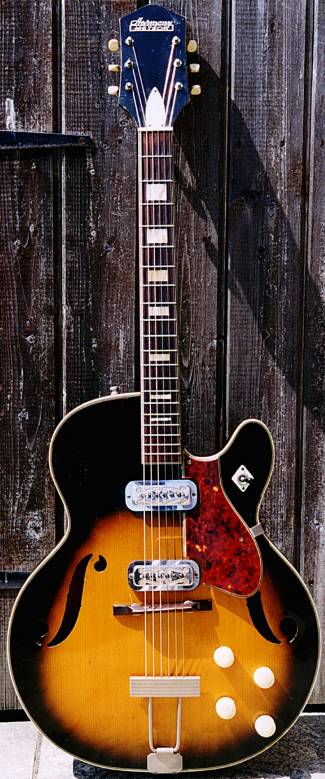
My love for those early Rolling Stones records eventually led me to seek out the guitar Sir Keef used to create the sound that once moved my pre-pubescent limbs into paroxysms of air-guitar ecstasy. Turns out that anonymous-looking electric arch-top, barely distinguishable on the monochrome TV sets of the day, was an early-60's Harmony Meteor. Neither opulent nor expensive, its sound nonetheless suited the raw excitement of the impoverished Stones' music, which would catapult them to world-wide super-stardom within a short couple of years.
Harmony is one of America's biggest success stories in the world of musical instrument manufacture. From its beginnings at around the turn of the last century, up to its dissolution in 1974, the company produced literally millions of stringed instruments and amplifiers at its Chicago plant, including franchises for Kay, Stella and Holiday, Sears Roebuck's Silvertone, even an acoustic student guitar for Fender. Their motto, "The Best You Can Buy For The Money You Spend", was no idle sales waffle; purchasers were often pleasantly surprised to discover how much guitar they received for their outlay, as indeed I was when I finally tracked this one down.
Harmony's Meteor was part of their "Professional" series of electric arch-tops from the late 1950's, based on the popular Rocket model (stay tuned), but with a bound, block-inlaid fingerboard, larger head-stock and bigger, fancier f-holes. Other improvements included a heavy-duty trapeze-style tail-piece which increased volume and sustain, and the new Rowe Industries DeArmond "Indox" pickups (though the earliest examples were fitted with DeArmond "Golden Tone" units).
Despite the quantities produced, the Meteor proved to be particularly elusive on the second-hand market here in the UK. I finally bought this one, in a less-than-perfect condition, early in 1997 with a view to cleaning it up and hanging it on the wall as a sort of trophy, a shrine to Keith! Scruffy as it was, it did surprisingly have all of its original parts (including the rare and oft-discarded torty-grain pick-guard), and the tatty fibre case it was supplied with. Once I'd pulled the guitar apart (and removed a fur-ball you could have stuffed a cushion with!), I was amazed by the quality of the electronic components and wiring, all super-screened to avoid short-circuits and external interference. The tone controls had different-value capacitors for each pickup. The switch, pots and socket were of the same specs used by Gibson and Fender and just required a thorough cleaning. All that expense for such a crappy little guitar! Or so I thought…
Once restored and set up, the guitar came back to life…with a twang. I still can't believe how good it sounds, or indeed why. Let's consider the evidence: OK, you've got your maple back and sides and laminated spruce top, fair enough. But it's hollow! Then there's that bolt-on maple neck, dinky 24¼" scale, and a non-fixed wooden bridge. Shouldn't happen! And yet…by some divine coincidence, those fabulous DeArmond pick-ups magically complement the natural tone of the wood, giving the strings a rich, warm timbre with bite and attack to spare. You're not likely to get into Incubus with it, but if you hanker for those long-lost sounds of the early 'sixties, when twang was most definitely the thang, try a Harmony at your local pawn-shop soon. You'll be glad you did!
For a great web-site devoted to Harmony guitars, visit www.rothguitar.com
Happy surfin'!